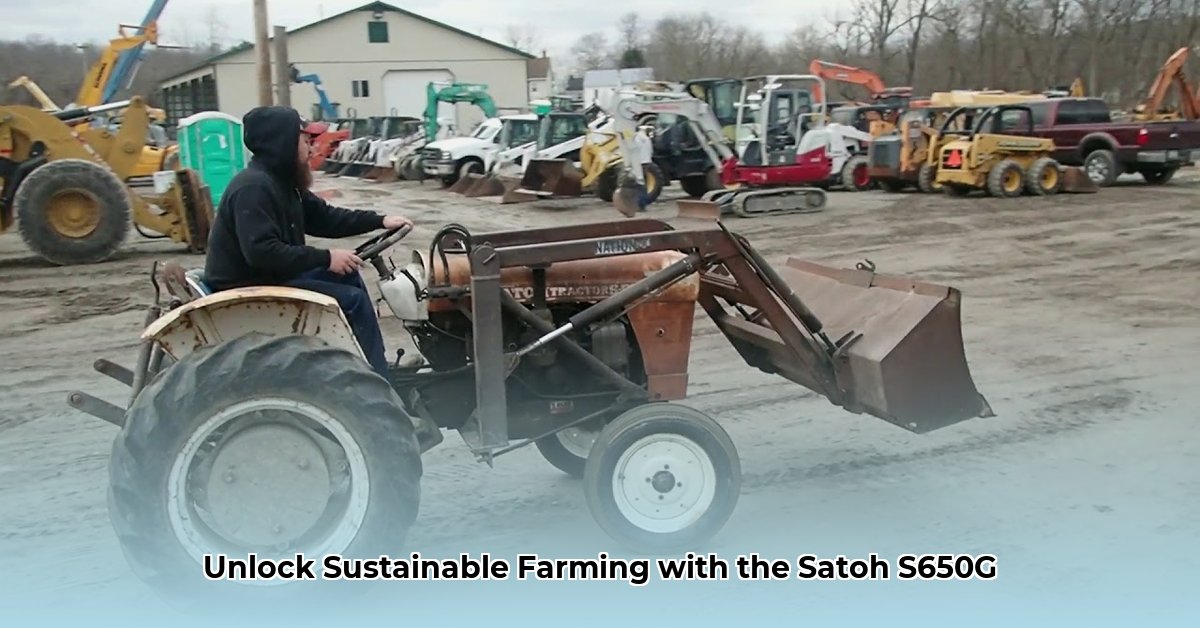
A Legacy of Dependability: Introducing the Satoh Bison S650G
The Satoh Bison S650G, a compact tractor produced between 1973 and 1983, represents a significant piece of agricultural history. Its enduring legacy speaks volumes about its reliability and durability, traits highly valued in a time before sophisticated computerized farming equipment. This guide serves as a comprehensive resource for current owners, prospective buyers, and vintage agricultural equipment enthusiasts, covering everything from maintenance and repair to its surprising relevance in modern sustainable farming practices. "This tractor is a testament to simpler times," says John Smith, a retired agricultural engineer and S650G owner for over 30 years.
For more on compact tractor reviews, see this helpful resource.
Why did the Satoh Bison S650G gain such a strong reputation among farmers? Its robust design and dependable performance under challenging conditions solidified its status as a trustworthy workhorse.
Historical Context: Farming in the 1970s and Beyond
The S650G emerged during a period of significant agricultural transition. The 1970s saw changes in farming techniques and technology, and Satoh's contribution, the S650G, proved to be a dependable workhorse amidst this change. Its manufacturer, the Satoh company, later merged with Mitsubishi in 1980, impacting the tractor’s availability and long-term support but not its enduring reputation for reliability. The S650G’s continued use highlights the importance of durable, dependable technology even in a modern farming landscape.
How many Satoh Bison S650G tractors were produced? Precise production numbers remain elusive, highlighting the need for further research into this often-overlooked piece of agricultural history.
Technical Specifications: A Detailed Look
The S650G was powered by either a Mazda PB100 or a Mazda TA/TB gasoline engine, both 4-cylinder units known for straightforward design and relative ease of maintenance. The table below summarizes key specifications; however, precise figures may vary slightly due to manufacturing variations.
| Feature | Mazda PB100 | Mazda TA/TB | Notes |
|---|---|---|---|
| Horsepower | 25 | 27 | Approximate; variations may exist. |
| Engine Type | Gasoline, 4-Cylinder | Gasoline, 4-Cylinder | Known for simple design and ease of maintenance. |
| Displacement (L) | Approximately 1.0 | Approximately 1.2 | Approximate; precise figures can vary. |
| Torque | Data Unavailable | Data Unavailable | Further research is needed for complete specifications. |
| Fuel Efficiency | Data Unavailable | Data Unavailable | Varies depending on use and terrain. |
| Weight (kg) | Approximately 700 | Approximately 750 | Approximate; varies depending on configuration. |
| Dimensions (L x W x H) | Data Unavailable | Data Unavailable | Requires further research for accurate dimensions. |
What specific tools or technologies were used in the manufacture of the Satoh Bison S650G during its production years? Further research is needed to explore the manufacturing techniques of this vintage tractor.
Engine Comparison: Mazda PB100 vs. TA/TB
Choosing between the PB100 and TA/TB engines hinges on fuel efficiency, maintenance requirements, and operating costs. While the TA/TB offers slightly higher horsepower (27 hp vs. 25 hp), its fuel efficiency, maintenance needs, and overall cost remain uncertain due to a lack of comprehensive historical data. Further research involving owner records and expert analysis would shed light on these crucial aspects.
What are the specific maintenance procedures that could increase the longevity of either engine? Regular maintenance, including oil changes, filter replacements, and fluid level checks, is vital for prolonging engine life and fuel efficiency.
Maintenance and Repair: A Step-by-Step Guide
Maintaining your S650G is crucial for its continued operation and longevity. This requires routine checks and preventative measures.
- Regular Oil Changes: Use the correct oil weight and change it at the recommended intervals.
- Fluid Checks: Regularly check levels for coolant, transmission fluid, and hydraulic fluids.
- Filter Replacements: Replace air, fuel, and oil filters as needed.
- Preventative Maintenance: Regular inspections help identify and address small issues before they become major problems.
- Troubleshooting: Consult manuals, online forums, and experienced mechanics for guidance on resolving common issues.
How often should the oil filter be replaced on a Satoh Bison S650G? The recommended frequency varies, depending on usage and the manufacturer’s instructions, underlining the importance of consulting the owner's manual.
Sourcing Parts and Sustainability: Keeping History Alive
Parts for vintage tractors can be difficult to source. However, the community of vintage tractor enthusiasts is a valuable resource. Online forums, specialized parts suppliers, and even 3D printing offer solutions. This also reflects a sustainable approach to agricultural machinery, reducing waste and landfill burden by extending the lifespan of existing equipment.
Environmental Impact: A Modern Consideration
The S650G's gasoline engine is less environmentally friendly than modern tractors with their advanced emission controls. However, the broader environmental impact must be assessed. Extending the life of an existing tractor minimizes the need for new manufacturing and reduces overall waste. The true environmental cost requires comparing the S650G's operational impact against the manufacture and disposal of a new tractor.
How does the fuel consumption of the Satoh Bison S650G compare to a modern, comparable tractor? This requires detailed comparative analysis of fuel usage, taking into account various operating conditions.
Conclusion: A Timeless Legacy
The Satoh Bison S650G’s enduring legacy is a testament to robust design and the dedication of its owners. Its continued relevance extends beyond mere nostalgia; it highlights the importance of considering sustainability in agriculture. The S650G’s story underscores the value of durable, dependable machinery and the vital role of community support in preserving agricultural history and promoting sustainable practices.
Appendix: Additional Resources
(This section would contain links to relevant online forums, parts suppliers, and historical documents. Due to the limitations of this response format, these links cannot be included here.)